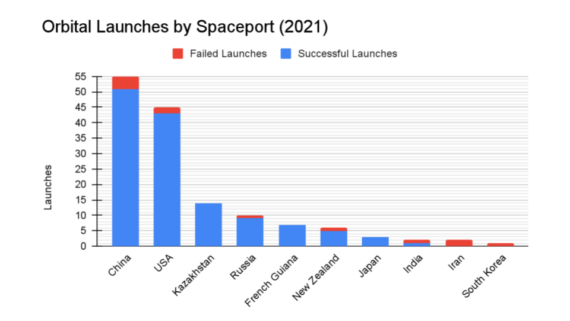
2021 was another rough year for pretty much everyone. In case you missed it, there’s a pandemic going on, supply chain issues abound, and there is still a microchip shortage.
Despite that, the space industry achieved a lot. There were 145 orbital launch attempts — the most since 1967. Most, 133, were successful. We keep track of orbital launches by launch location, also known as spaceport. Please keep in mind that these numbers do not include suborbital flights, such as the Starship tests or New Shepard.
The 2021 totals were:
China 55, USA 45, Kazakhstan 14, Russia 10, French Guiana 7, New Zealand 6, Japan 3, India 2, Iran 2, South Korea 1
Like in 2020, China launched more rockets than anyone else, closely followed by the US. Thirty one out of 45 US launches were SpaceX launches. Five of the Falcon 9 boosters launched more times than rockets by several individual countries. In fact, Booster 1060 launched six times just last year, matching the total combined number of launches by South Korea, India, and Japan.
The smallest rocket launched in 2021 was Astra’s Rocket 3.3, and the largest rocket launched was ULA’s Delta 4 Heavy.
From the 133 successful launches, the most ever in a year, 27 humans were put into orbit as well as 1,778 spacecraft and satellites. Additionally, 16,675kg of cargo was sent to the ISS. That’s the equivalent of three elephants sent to space, to a place the size of an average house. Two spacecraft left Earth for destinations around the solar system: NASA’s Lucy to the Jupiter Trojans, and the DART mission to the binary asteroid Didymos.
Last year, 989 SpaceX Starlink satellites were launched across 19 different launches, making up almost 60% of all satellites launched in 2021. Since 2019, a total of 1,944 Starlink satellites have been launched, including the Tintin and v0.9 series. As of December 31st 1,764 are currently functional with 151 reentered and 29 more on their way back into the atmosphere.
The first shell of the Starlink constellation was finally completed in late May with nearly 1600 satellites in 53 degree inclination orbits. After an extended downtime another several hundred satellites were launched for the 70 degree and 53.2 degree shells. These launches will continue into 2022 and beyond. The final Starlink constellation will eventually consist of over 4000 satellites.
In addition SpaceX launched two smallsat rideshare missions named Transporter 1 and Transporter 2 in January and June 2021 respectively. Transporter 1 broke the record for most satellites put into orbit on one rocket with a total of 143 satellites. In comparison, Transporter 2 had a mere 85 satellites. I know that sounds impressive, but keep in mind that most of them were about the size of a shoebox or smaller.
A lot of the launches in 2021 were for various satellite constellations. A constellation is a group of satellites put into different orbits which work together for different purposes, like navigation or communications.
OneWeb, which is another satellite internet provider, has its constellation much closer to completion than its competitor, Starlink. Last year, Russian Soyuz rockets launched 284 more satellites in seven launches from both the Vostochny and Baikonur Cosmodrome’s for a total of 394 satellites in orbit, or 60% complete.
The European Union’s Galileo constellation got one step closer to completion with two more satellites launched in late 2021, satellites 27 and 28.
Speaking of satellite navigation constellations, the United States’ GPS III constellation had one more satellite launch in 2021. Further satellites were delayed because of the ongoing pandemic.
Black Sky Global doubled their constellation of imaging satellites after a series of dedicated launches of Electron rockets and one SpaceX rideshare.
It’s more difficult to keep track of how many of them are in orbit or how many satellites the total constellation will be but Planetlabs kept launching Flocks of their Dove imaging satellites into orbit, 48 on SpaceX’s Transporter 1 and 44 on Transporter 2.
Read More
Starlink Statistics- Johnathan McDowell’s Planet4859




 Join the Crew!
Join the Crew!
 Escape Velocity Space News
Escape Velocity Space News
0 Comments
Trackbacks/Pingbacks